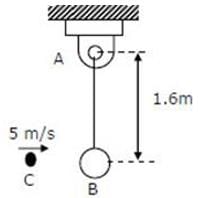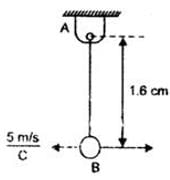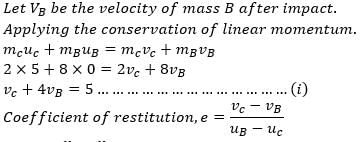GATE Exam > GATE Questions > The 2 kg mass C moving horizontally to the ri...
Start Learning for Free
The 2 kg mass C moving horizontally to the right, with a velocity of 5 m/s, strikes the 8 kg mass B at the lower end of the rigid massless rod AB. The rod is suspended from a frictionless hinge at A and is initially at rest. If the coefficient of restitution between mass C and mass B is one, determine the angular velocity of the rod AB immediately after impact.


- a)1.25 rad/s
- b)0.725 rad/s
- c)0.425 rad/s
- d)0.825 rad/s
Correct answer is option 'A'. Can you explain this answer?
| FREE This question is part of | Download PDF Attempt this Test |
Verified Answer
The 2 kg mass C moving horizontally to the right, with a velocity of 5...




|
Explore Courses for GATE exam
|

|
Similar GATE Doubts
The 2 kg mass C moving horizontally to the right, with a velocity of 5 m/s, strikes the 8 kg mass B at the lower end of the rigid massless rod AB. The rod is suspended from a frictionless hinge at A and is initially at rest. If the coefficient of restitution between mass C and mass B is one, determine the angular velocity of the rod AB immediately after impact.a)1.25 rad/sb)0.725 rad/sc)0.425 rad/sd)0.825 rad/sCorrect answer is option 'A'. Can you explain this answer?
Question Description
The 2 kg mass C moving horizontally to the right, with a velocity of 5 m/s, strikes the 8 kg mass B at the lower end of the rigid massless rod AB. The rod is suspended from a frictionless hinge at A and is initially at rest. If the coefficient of restitution between mass C and mass B is one, determine the angular velocity of the rod AB immediately after impact.a)1.25 rad/sb)0.725 rad/sc)0.425 rad/sd)0.825 rad/sCorrect answer is option 'A'. Can you explain this answer? for GATE 2024 is part of GATE preparation. The Question and answers have been prepared according to the GATE exam syllabus. Information about The 2 kg mass C moving horizontally to the right, with a velocity of 5 m/s, strikes the 8 kg mass B at the lower end of the rigid massless rod AB. The rod is suspended from a frictionless hinge at A and is initially at rest. If the coefficient of restitution between mass C and mass B is one, determine the angular velocity of the rod AB immediately after impact.a)1.25 rad/sb)0.725 rad/sc)0.425 rad/sd)0.825 rad/sCorrect answer is option 'A'. Can you explain this answer? covers all topics & solutions for GATE 2024 Exam. Find important definitions, questions, meanings, examples, exercises and tests below for The 2 kg mass C moving horizontally to the right, with a velocity of 5 m/s, strikes the 8 kg mass B at the lower end of the rigid massless rod AB. The rod is suspended from a frictionless hinge at A and is initially at rest. If the coefficient of restitution between mass C and mass B is one, determine the angular velocity of the rod AB immediately after impact.a)1.25 rad/sb)0.725 rad/sc)0.425 rad/sd)0.825 rad/sCorrect answer is option 'A'. Can you explain this answer?.
The 2 kg mass C moving horizontally to the right, with a velocity of 5 m/s, strikes the 8 kg mass B at the lower end of the rigid massless rod AB. The rod is suspended from a frictionless hinge at A and is initially at rest. If the coefficient of restitution between mass C and mass B is one, determine the angular velocity of the rod AB immediately after impact.a)1.25 rad/sb)0.725 rad/sc)0.425 rad/sd)0.825 rad/sCorrect answer is option 'A'. Can you explain this answer? for GATE 2024 is part of GATE preparation. The Question and answers have been prepared according to the GATE exam syllabus. Information about The 2 kg mass C moving horizontally to the right, with a velocity of 5 m/s, strikes the 8 kg mass B at the lower end of the rigid massless rod AB. The rod is suspended from a frictionless hinge at A and is initially at rest. If the coefficient of restitution between mass C and mass B is one, determine the angular velocity of the rod AB immediately after impact.a)1.25 rad/sb)0.725 rad/sc)0.425 rad/sd)0.825 rad/sCorrect answer is option 'A'. Can you explain this answer? covers all topics & solutions for GATE 2024 Exam. Find important definitions, questions, meanings, examples, exercises and tests below for The 2 kg mass C moving horizontally to the right, with a velocity of 5 m/s, strikes the 8 kg mass B at the lower end of the rigid massless rod AB. The rod is suspended from a frictionless hinge at A and is initially at rest. If the coefficient of restitution between mass C and mass B is one, determine the angular velocity of the rod AB immediately after impact.a)1.25 rad/sb)0.725 rad/sc)0.425 rad/sd)0.825 rad/sCorrect answer is option 'A'. Can you explain this answer?.
Solutions for The 2 kg mass C moving horizontally to the right, with a velocity of 5 m/s, strikes the 8 kg mass B at the lower end of the rigid massless rod AB. The rod is suspended from a frictionless hinge at A and is initially at rest. If the coefficient of restitution between mass C and mass B is one, determine the angular velocity of the rod AB immediately after impact.a)1.25 rad/sb)0.725 rad/sc)0.425 rad/sd)0.825 rad/sCorrect answer is option 'A'. Can you explain this answer? in English & in Hindi are available as part of our courses for GATE.
Download more important topics, notes, lectures and mock test series for GATE Exam by signing up for free.
Here you can find the meaning of The 2 kg mass C moving horizontally to the right, with a velocity of 5 m/s, strikes the 8 kg mass B at the lower end of the rigid massless rod AB. The rod is suspended from a frictionless hinge at A and is initially at rest. If the coefficient of restitution between mass C and mass B is one, determine the angular velocity of the rod AB immediately after impact.a)1.25 rad/sb)0.725 rad/sc)0.425 rad/sd)0.825 rad/sCorrect answer is option 'A'. Can you explain this answer? defined & explained in the simplest way possible. Besides giving the explanation of
The 2 kg mass C moving horizontally to the right, with a velocity of 5 m/s, strikes the 8 kg mass B at the lower end of the rigid massless rod AB. The rod is suspended from a frictionless hinge at A and is initially at rest. If the coefficient of restitution between mass C and mass B is one, determine the angular velocity of the rod AB immediately after impact.a)1.25 rad/sb)0.725 rad/sc)0.425 rad/sd)0.825 rad/sCorrect answer is option 'A'. Can you explain this answer?, a detailed solution for The 2 kg mass C moving horizontally to the right, with a velocity of 5 m/s, strikes the 8 kg mass B at the lower end of the rigid massless rod AB. The rod is suspended from a frictionless hinge at A and is initially at rest. If the coefficient of restitution between mass C and mass B is one, determine the angular velocity of the rod AB immediately after impact.a)1.25 rad/sb)0.725 rad/sc)0.425 rad/sd)0.825 rad/sCorrect answer is option 'A'. Can you explain this answer? has been provided alongside types of The 2 kg mass C moving horizontally to the right, with a velocity of 5 m/s, strikes the 8 kg mass B at the lower end of the rigid massless rod AB. The rod is suspended from a frictionless hinge at A and is initially at rest. If the coefficient of restitution between mass C and mass B is one, determine the angular velocity of the rod AB immediately after impact.a)1.25 rad/sb)0.725 rad/sc)0.425 rad/sd)0.825 rad/sCorrect answer is option 'A'. Can you explain this answer? theory, EduRev gives you an
ample number of questions to practice The 2 kg mass C moving horizontally to the right, with a velocity of 5 m/s, strikes the 8 kg mass B at the lower end of the rigid massless rod AB. The rod is suspended from a frictionless hinge at A and is initially at rest. If the coefficient of restitution between mass C and mass B is one, determine the angular velocity of the rod AB immediately after impact.a)1.25 rad/sb)0.725 rad/sc)0.425 rad/sd)0.825 rad/sCorrect answer is option 'A'. Can you explain this answer? tests, examples and also practice GATE tests.

|
Explore Courses for GATE exam
|

|
Suggested Free Tests
Signup for Free!
Signup to see your scores go up within 7 days! Learn & Practice with 1000+ FREE Notes, Videos & Tests.


















